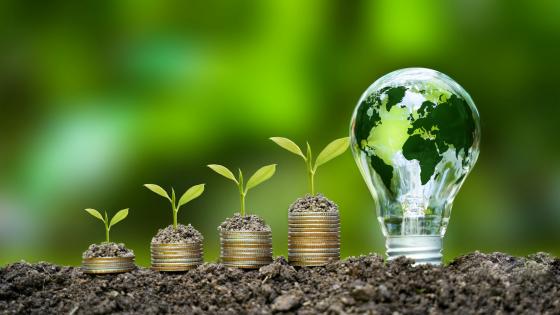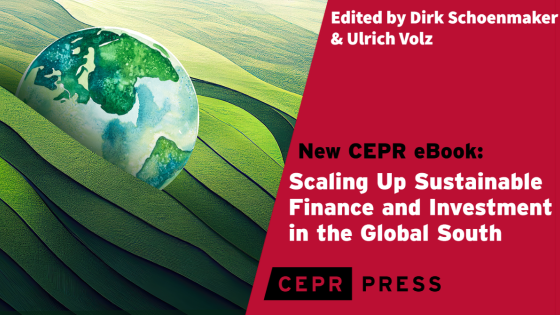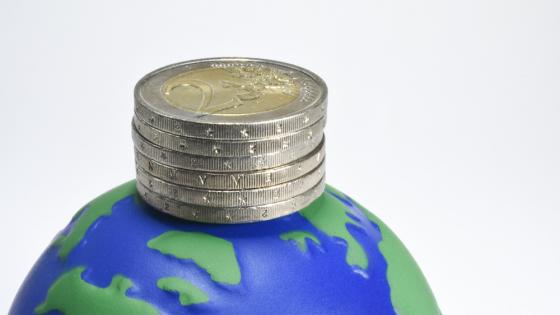A stable climate is one of the foundations of our welfare and wellbeing. In order to limit climate change, investments in climate mitigation are needed globally. It is in developing countries, where population growth and economic growth prospects are greatest, that climate mitigation investments need to grow the most (IPCC 2022).
Currently, however, liquidity constrained low-income countries are often not able to invest in renewable energies, despite the fact that the life cycle costs of renewable energy production is in most places already lower than that of fossil fuel options. However, renewable energies do come with higher initial investment costs due to the relatively high capital expenditures. Investments that are often prohibitively expensive for low-income countries (Schoenmaker and Volz 2022, van Tilburg et al. 2022). The cost of capital for a solar PV project in advanced economies and China is around 4%, whilst for emerging and developing economies this figure is around 12% (IEA 2022).
In absolute terms, developing countries now need to invest annually $1 trillion more in climate mitigation (Bhattacharya et al. 2022). On top of this come costs of climate adaptation of $300 billion (UNEP 2021) and up to $580 billion for loss and damage by 2030 (Markandya and Gonzalez-Eguino 2018). Against these numbers, the 2009 promise of high-income countries to bring $100 billion to the table – a promise that still has not been fulfilled – pales.
At COP27 a roadmap was presented for how to get the needed extra climate mitigation investments by 2025. According to this roadmap, most is expected from two sources of finance: domestic resource mobilisation and private finance, with an increase of $417 billion (from $236 billion) and $326 billion (from $69 billion), respectively (Songwe et al. 2022). With many developing countries struggling with their debt situation and private finance flows to many low-income countries on a downward trajectory, other sources of public finance are needed (Murawski et al. 2023).
Special Drawing Rights delivering the billions needed
One rare source of finance for developing countries that has increased since 2021 is the IMF’s Special Drawing Rights (SDRs). At the height of the pandemic, the IMF created $650 billion worth of SDRs. Developing countries were able to trade these for the much needed dollars and euros to invest in their health and social support systems. The $53 billion of SDRs that went to lower-middle-income countries and $9 billion to low-income countries have quickly been spent.
The G20 committed to reallocate another $100 billion of SDRs to developing countries. Up to around $60 billion of this can be absorbed by two IMF-trusts: the already existing Poverty Reduction and Growth Trust (PRGT) and the newly created Resilience and Sustainability Trust (RST). While the $60 billion limit for the combined IMF trusts is not set in stone, it is also not easy to expand these by too much – the reasons for this being the capacity to distribute the funds and the real money needed to provide the loans on concessional terms.
Rechannelling through Multilateral Development Banks
Given the limitations of the IMF trusts, proposals have been made to rechannel SDRs through Multilateral Development Banks (MDBs) like the World Bank and its regional counterparts the African and Asian Development Banks. These MDBs have a much broader apparatus and longer experience with development and climate finance in developing countries. They have thus a large potential to scale up their climate finance. MDBs can bring down the currently often prohibitively high cost of climate finance to acceptable levels.
MDBs have tried and tested methods of leveraging private finance for development. For instance, the International Bank for Reconstruction and Development has leveraged the total paid-in capital by a factor of ten (Humphrey and Prizzon 2020). By doing so, MDBs can also create safe, investable local currency assets that can attract domestic savings. Domestic savings that currently are exported to a large extent at low returns to financial centres in advanced countries (Schoenmaker and Volz 2022).
Most MDBs are already prescribed holders of SDRs. One option therefore is for MDBs to issue ‘SDR-bonds’ (Setser and Paduano 2023). As this is structured as a security, it is easy for all the major SDR holders to purchase it. Most importantly, this would allow the US to make good on its pledge to rechannel $20 billion of SDRs. The SDR bond would strengthen the MDBs’ liability structure by providing them with a low-cost, long-term financing source. This should facilitate MDBs in the implementation of capital adequacy reform to reduce their equity-to-loan ratio limits. An even more effective use of SDRs for MDBs is to use them as hybrid capital which can be leveraged at the rate of four to one, as proposed by the African and the Inter American Development Banks (Plant 2023).
Yet, the largest block of SDR holders – the members of the EU, which hold around $200 billion of the roughly $900 billion of SDRs – are still in doubt as to whether they can rechannel their SDRs to MDBs. The reason for this are previous legal opinions of the ECB that indicate that not all rechannelling of SDRs to MDBs may be compatible with the EU's legal framework, more specifically with the monetary financing prohibition. However, no legal opinion has been published by the ECB yet on the two specific proposals discussed here. Given that these preserve the reserve asset status of the rechannelled SDRs and are being used for similar purposes as the IMF trusts that have received clearing by the ECB, it should be possible to also allow this use of the SDRs by EU member states. What’s more, the European Investment Bank already has access to Eurosystem reserve assets through its access to the ECB’s repo facility and borrowings from Eurosystem national central banks (Paduano 2023).
Conclusion
Rechannelling SDRs to MDBs has the potential to increase the available capital for climate investments where it is needed most: in developing countries. Given that no clear substitutes are in sight, this route deserves priority in being explored and made passable through finding a construction that is compatible with the EU's legal framework.
References
African Development Bank Group (2022), African Economic Outlook 2022.
Bhattacharya, A, M Dooley, H Kharas and C Taylor (2022), “Financing a big investment push in emerging markets and developing countries for sustainable, resilient and inclusive recovery and growth”, LSE Grantham.
Humphrey, C and A Prizzon (2020), “Scaling up multilateral bank finance for the Covid-19 recovery”, ODI Insights, Overseas Development Institute.
IEA (2022), World Energy Investment 2022.
IPCC (2022), Climate Change 2022: Mitigation of Climate Change Technical summary, Working Group III contribution to the Sixth Assessment Report of the Intergovernmental Panel on Climate Change.
Markandya, A, and M. González-Eguino (2018), “Integrated Assessment for Identifying Climate Finance Needs for Loss and Damage: A Critical Review”, in R Mechler, L Bouwer, T Schinko, S Surminski and J Linnerooth-Bayer “Loss and Damage from Climate Change: Concepts, Methods and Policy Options”, SpringerLink.
Murawski, S, R van Tilburg and A Ghilardi (2023), “The dangerously optimistic global climate finance agenda”, blog Institute of Social Studies.
Paduano, S (2023), “SDR Rechanneling and ECB Rules: Why rechanneling SDRs to Multilateral Development Banks is not always and everywhere monetary financing, Finance for Development Lab Policy Note 7, May.
Plant, M (2023), “Funding Hybrid Capital at the AfDB is the Best Deal for SDR Donors”, Centre for Global Development.
Schoenmaker, D, and U Volz (2022), Scaling Up Sustainable Finance and Investment in the Global South, CEPR press.
Setser, B, and S Paduano (2023), “How an SDR denominated bond could work”, Council on Foreign Relations.
Songwe V, N Stern and A Bhattacharya (2022), “Finance for climate action: scaling up investment for climate and development”, Independent High-Level Expert Group on Climate Finance.
Van Tilburg, R, A Simic and R Timonen (2022), “Leaving no country behind: a monetary contribution to close the climate finance gap”, Sustainable Finance Lab working paper, November.



